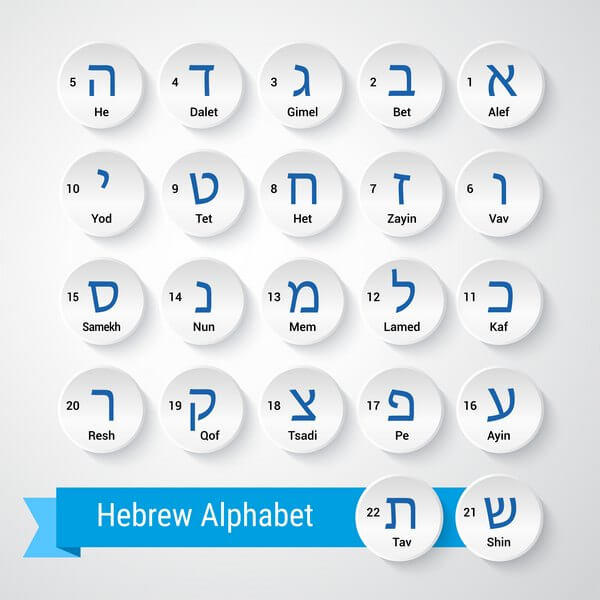Hebrew Translation and Interpreting
Since 1993, we at LEXIKA have been providing translations of various Hebrew documents. We translate Hebrew documents mainly into English and German. We can also provide you with reliable translations into other European and world languages or from these languages into Hebrew.
We offer you fast delivery of reasonably-priced translations of official and identity documents or diplomas.

Why choose LEXIKA for your Hebrew translations?
All translations are processed strictly according to the agreement made with the client and in compliance with the established deadlines. High quality translation and interpretation services are our main concern.
We are a preferred provider of translations from foreign languages into English and various languages of Central and Eastern Europe for corporate clients. This fact speaks of our dependability and the high quality of our services.
Apart from the quality of the provided translation services, our customers appreciate our high level of professionalism and our willingness and ability to meet their specific requirements.
In addition to the Hebrew certified translation, we also provide Hebrew translations of company, business and technical documentation. They most commonly include translations of contracts, company regulations and dispute-related documents.
Over the course of more than 20 years, many regional and global companies have decided to take advantage of our services and we have provided them with tens of thousands of translation projects.
How do we do it?
Specialist translators
Our translators work in more than 120 different specialisations and we carefully select the most suitable linguist with regards to the linguistic and terminological characteristics of the text to be translated. You can thus be sure that your text is translated by an expert in the given field.
Quality tested to international standards
LEXIKA guarantees systematic processing of all requirements and compliance with procedures according to ISO 9001 by using a certified system of quality management that is audited annually. For our customers, we always select the optimum means of carrying out their translation project at the most suitable translation service level. We recommend you have all your text translated in compliance with ISO 17100. The said standard guarantees that the high quality requirements placed on translators, reviewers and the entire translation process are fulfilled.
Modern technologies
All texts are translated by translators whose work is considerably enhanced by modern translation tools. They help us use consistent terminology resulting in a more effective translation process that meets higher quality standards. Technologies can also reduce translation costs to some extent.
Quality assurance
The quality assurance process verifies the use of terminology defined by the client and the correct use of translation procedures including all revisions, spelling corrections, proofreading and compliance with any specific client requirements. Even though we use modern procedures and software tools to assure quality, we always make sure that each translation is checked by the careful eye of our quality assessor.
Interested in using our services?
Leave us a message with your requirements and we’ll get back to you
A language successfully brought back to life
Bruchim ha’baim – Welcome. This is the sign that greets you when you land at an airport in Israel – the country with the highest number of Hebrew speakers. There are around 9 million speakers of Modern Hebrew living predominantly in Israel and its neighbouring countries but due to immigration also in the United States of America. Actually, wherever the Jews live.
If you are wondering why we used the term 'Modern Hebrew', we will explain for you. Modern Hebrew (called Ivrit in Hebrew) is a member of the Semitic language group (or to the Canaanite group to be more precise) even though some people consider it to be more of an Indo-European language due to its numerous language borrowings and loan words. It has quite an eventful history and is one of the few world languages that were, metaphorically speaking, brought back to life. Why did it cease to exist and how did it reclaim its place?

Rise, fall and rise of Hebrew
From the point of view of history, the development of Hebrew can be divided into four subsequent phases. The first phase began in the Middle Ages. It is the period of Biblical Hebrew, the language in which the Tanakh is written (sacred texts that are part of the Bible). Historically significant Qumran manuscripts, which explain the then language and vocabulary, have also been preserved from this period. After the conquest of the Kingdom of Israel and Judah in the 1st century BC, the Hebrew language got pushed out by Aramaic.
We are gradually reaching the 2nd century characterised by Mishnaic Hebrew. The language continued under the influence of the religion (Judaism) and this fact is reflected in its name. Mishnah is a collection of Jewish religious texts and provisions, and only represents a part of the entire Jewish teaching. One interesting fact about this period is that at this time, Hebrew borrowed a lot of Greek, Latin, and Persian words and its sentence structure became simplified compared to Biblical Hebrew. Mishnaic Hebrew ceased to be used in everyday communication in approximately the 3rd century.

The third period is the period of Medieval Hebrew. Hebrew was not a dead language in the real sense of the word bus was used chiefly as a written language. In everyday communication, the Jews used the languages spoken in the countries where they lived. Further development of their religion gave rise to many coinages and Hebrewised words.
The Zionist movement in the 19th century stood at the beginning of Modern Hebrew. The Israel-based linguist Eliezer Ben-Yehuda began promoting a common language for the Jewish inhabitants of Israel that was intended to unite them. This role was later played by Modern Hebrew, which till a certain extent replaced Arabic, Yiddish, German, Russian, French, and English, which were spoken by many Jewish immigrants to Israel. Almost the whole grammatical system was borrowed from Biblical Hebrew. Under the influence of the Indo-European languages, new words were quickly coined and the pronunciation altered. In 1948, Modern Hebrew became the official language of Israel.

No vowels? Great!
The present-day Hebrew alphabet contains 22 consonants but if you do not know Hebrew words and how to read them you will not be able to read the text correctly without the so called vocalization. Vocalization and accents are used only as an aid e.g. for learners of Hebrew, children or to read sacred Hebrew texts. The script is old and it has developed gradually. Similarly to the Arabic language, Hebrew is written from right to left. One of the theories says that the reason is the fact that it is easier to carve marks into stone tablets with the hammer being held in the right hand which is stronger and the chisel in the left hand.
Would you like to try repeating a Hebrew tongue-twister? The sentence נחש נשך נחש שנשך נחש, which can be pronounced as Nachash nachash nachash shenashach nachash, means A snake bit a snake that bit a snake. Hebrew has a diverse vocabulary containing a lot of loan terms. We all know Hebrew words such as hallelujah, amen or abracadabra.
